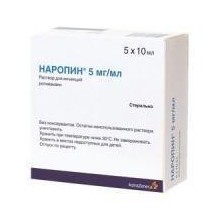



Naropin - the first local anesthetic of the long-acting amide type, which is a pure enantiomer. It has both anesthetic and analgesic effects.
High doses of the drug are used for local anesthesia during surgical interventions, low doses of the drug provide analgesia (sensory block) with a minimal and not progressive motor block.
The duration and intensity of the blockade caused by ropivacaine, the addition of adrenaline does not affect. Reversibly blocking voltage-dependent sodium channels, prevents the generation of impulses at the end of the sensory nerves and conduction of impulses along the nerve fibers.
Like other local anesthetics, it can affect other excitable cell membranes (for example, in the brain and myocardium). If an excess amount of local anesthetic reaches the systemic circulation in a short period of time, signs of systemic toxicity are possible.
Signs of toxicity on the part of the central nervous system are preceded by signs of toxicity on the part of the cardiovascular system, as they are observed at lower plasma concentrations of the drug.
The direct action of local anesthetics on the heart includes a slower conduction, a negative inotropic effect and, in severe overdose, arrhythmias and cardiac arrest. Intravenous administration of high doses of ropivacaine leads to the same effects on the heart.
Intravenous infusions of ropivacaine to healthy volunteers showed its good tolerability. Indirect cardiovascular effects (lowering blood pressure, bradycardia) that may occur after epidural administration of ropivacaine are due to the resulting sympathetic blockade.
Local anesthesia:
1 ml contains ropivacaine hydrochloride 5 mg
No customer reviews for the moment.
Naropin It should be used only by specialists with sufficient experience in conducting regional anesthesia, or under their supervision.
When selecting the dose of the drug should be based on clinical experience, taking into account the physical status of the patient.
In general, anesthesia for surgical interventions (for example, for epidural administration) requires higher doses and more concentrated solutions of the drug.
When anesthesia (for example, epidural administration for the relief of pain), lower doses and concentrations of the drug are recommended.
Unwanted reactions toNaropin similar to reactions to other local anesthetics amide type. They should be distinguished from the physiological effects arising from the blockade of sympathetic nerves during epidural anesthesia, such as a decrease in blood pressure, bradycardia, or effects associated with the administration of the drug, such as local nerve damage, meningitis, postfunctional headache, epidural abscess.
Side Effects of Local Anesthetics
From the central and peripheral nervous system
Possible neuropathy and dysfunction of the spinal cord (anterior spinal artery syndrome, arachnoiditis, horse tail syndrome), usually associated with the technique of regional anesthesia, and not with the effect of the drug.
As a result of accidental intrathecal administration of an epidural dose, a complete spinal block can occur.
Serious complications are possible with systemic overdose and unintentional intravascular administration of the drug (see the “Overdose” section).
Acute systemic toxicity
Naropin may cause acute systemic toxic reactions when using high doses or with a rapid increase in its concentration in the blood in case of accidental intravascular administration of the drug or its overdose (see the section “Overdose”).
The most common side effects
Various side effects of the drug were reported, the overwhelming majority of which were associated not with the effect of the anesthetic used, but with the technique of regional anesthesia.
Most often (> 1%) the following side effects were noted, which were regarded as having clinical significance regardless of whether a causal relationship was established with the use of anesthetic: decrease in blood pressure *, nausea, bradycardia, vomiting, paresthesia, fever , headache, urinary retention, dizziness, chills, increased blood pressure, tachycardia, hypoesthesia, anxiety.
Often
From the CCC: a decrease in blood pressure.
From the digestive tract: nausea.
Often
From the nervous system: paresthesia, dizziness, headache.
From the CCC: bradycardia, tachycardia, hypertension.
From the digestive tract: vomiting.
From the genitourinary system: urinary retention.
Are common: back pain, chills, fever.
Infrequently
From the nervous system: anxiety, symptoms of toxicity from the central nervous system (convulsions, major seizures, paresthesias in the perioral zone, dysarthria, numbness of the tongue, visual impairment, tinnitus, tremor, muscle cramps), hypoesthesia.
From the vascular system: fainting.
On the part of the respiratory system: shortness of breath, difficulty breathing.
Are common: hypothermia.
Seldom
From the CCC: arrhythmia, cardiac arrest.
Are common: allergic reactions (anaphylactic reactions, angioedema, urticaria).
Enhances the toxic effect of other local anesthetics and drugs, the structure similar to local anesthetics amide type.
Carefully. Use for anesthesia or analgesia in obstetrics is justified.
Patients with severe liver disease need to reduce repeated doses. Avoid long-term use in conjunction with fluxamine.
Be careful when using vehicle drivers and people whose profession is related to increased concentration of attention.
Symptoms: visual and hearing impairment, hypotension, arrhythmia, dysarthria, increased muscle tone, muscle twitching, convulsions, loss of consciousness, hypoxia, hypercapnia, respiratory failure or stopping.
Treatment: stopping the administration of the drug, maintaining adequate oxygenation, stopping convulsions and convulsions (intravenous thiopental 100–120 mg or diazepam 5–10 mg), normalization of blood circulation, correction of acidosis; with the development of hypotension and bradycardia - IV the introduction of 5-10 mg of ephedrine (possibly again after 2-3 minutes).
Studies and clinical trials of Ropivacaine (Click to expand)